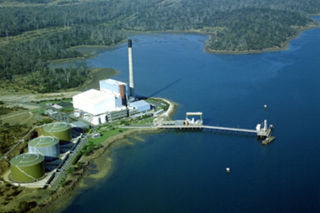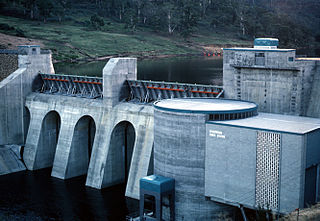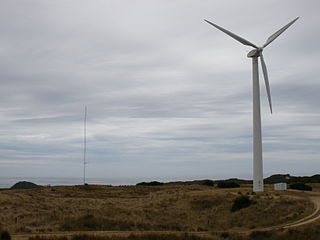
A combined cycle power plant is an assembly of heat engines that work in tandem from the same source of heat, converting it into mechanical energy. On land, when used to make electricity the most common type is called a combined cycle gas turbine (CCGT) plant, which is a kind of gas-fired power plant. The same principle is also used for marine propulsion, where it is called a combined gas and steam (COGAS) plant. Combining two or more thermodynamic cycles improves overall efficiency, which reduces fuel costs.

George Town is a large town in north-east Tasmania, on the eastern bank of the mouth of the Tamar River. The Australian Bureau of Statistics records the George Town Municipal Area had a population of 6,764 as of 30 June 2016.

Hydro Tasmania, known for most of its history as the Hydro-Electric Commission (HEC) or The Hydro, is the trading name of the Hydro-Electric Corporation, a Tasmanian Government business enterprise which is the predominant electricity generator in the state of Tasmania, Australia. The Hydro was originally oriented towards hydro-electricity, due to Tasmania's dramatic topography and relatively high rainfall in the central and western parts of the state. Today Hydro Tasmania operates thirty hydro-electric and one gas power station, and is a joint owner in three wind farms.

Transend Networks Pty Ltd was a Tasmanian government-owned business which operated between 1998 and 2014 as the electricity transmission network provider for Tasmania, Australia. It was formed by the disaggregation of the Hydro-Electric Commission, and ceased operation when it was merged on 1 July 2014 with the distribution division of Aurora Energy to form the combined network business TasNetworks.

Aurora Energy is a Tasmanian Government-owned electricity retailer in Tasmania, Australia.
The National Electricity Market (NEM) is an arrangement in Australia's electricity sector for the connection of the electricity transmission grids of the eastern and southern Australia states and territories to create a cross-state wholesale electricity market. The Australian Energy Market Commission develops and maintains the Australian National Electricity Rules (NER), which have the force of law in the states and territories participating in NEM. The Rules are enforced by the Australian Energy Regulator. The day-to-day management of NEM is performed by the Australian Energy Market Operator.

The Loy Yang Power Station is a brown coal- fired thermal power station located on the outskirts of the city of Traralgon, in south-eastern Victoria, Australia. It consists of two sections, known as Loy Yang A and Loy Yang B. Both Loy Yang A and B are supplied by the Loy Yang brown coal mine. The Loy Yang power stations are located in the brown coal rich Latrobe Valley, along with the Yallourn Power Station.

The Bell Bay Power Station was a power station located in Bell Bay, on the Tamar River, Tasmania, Australia, adjacent to the Tamar Valley Power Station, with which it was often confused. It was commissioned between 1971 and 1974 as an oil fired thermal power station, and was converted to natural gas in 2003, after the commissioning of the Tasmanian Gas Pipeline, a submarine gas pipeline which transports natural gas from Longford, Victoria, under Bass Strait, to Bell Bay, Tasmania. As the power station's primary role was to provide system security in the event of drought for Tasmania's predominantly hydro-electric based generation system it only was rarely called on to operate, resulting in intervals of five to eight years between periods of significant use. After the commissioning of Basslink in 2006, the power station was decommissioned in 2009.

The Meadowbank Power Station is a run-of-the-river hydroelectric power station located in the Central Highlands region of Tasmania, Australia. The power station is situated on the Lower River Derwent catchment and is owned and operated by Hydro Tasmania.

Huxley Hill Wind Farm is a wind power station at King Island, Tasmania, Australia, of around 1600 residents, owned by Hydro Tasmania, which supplements the four diesel generators with a combined capacity of 6 MW at Currie Power Station. King Island also has a 100 kW solar capacity provided with monocrystaline solar panels on dual-axis arrays.

AGL Energy Ltd is an Australian listed public company involved in both the generation and retailing of electricity and gas for residential and commercial use. AGL is Australia's largest electricity generator, and the nation's largest carbon emitter. In 2022, 83% of its energy came from burning coal. It produces more emissions as a single company than the nations of New Zealand, Portugal or Sweden, according to its largest shareholder, Mike Cannon-Brookes, who named it "one of the most toxic companies on the planet".

The Gordon Dam, also known as the Gordon River Dam, is a major gated double curvature concrete arch dam with a controlled spillway across the Gordon River, located in Southwest National Park, Tasmania, Australia. The impounded reservoir is called Lake Gordon.

Braemar Power Station is a complex of natural gas and coal seam gas fired combined-cycle power stations in Kogan, Western Downs Region, Queensland, Australia. It is near Dalby in the Darling Downs region.
The Basslink electricity interconnector is a 370 km (230 mi) 500 MW (670,000 hp) high-voltage direct current (HVDC) cable linking the electricity grids of the states of Victoria and Tasmania in Australia, crossing Bass Strait, connecting the Loy Yang Power Station, Victoria on the Australian mainland to the George Town substation in northern Tasmania. Basslink is bidirectional and enables Hydro Tasmania to supply some of the peak load capacity to the Australian mainland and take some of the excess power from the mainland when the generation on the mainland exceeds the demand.

The Tatan Power Plant, Dah-Tarn Power Plant or Ta-Tan Power Plant is a gas-fired power plant in Guanyin District, Taoyuan City, Taiwan. At the capacity of 4,384 MW, the plant is the world's largest gas turbine combined cycle power plant and Taiwan's largest gas-fired power plant.

The electricity sector in Australia has been historically dominated by coal-fired power stations, but renewables are forming a rapidly growing fraction of supply. In 2021, Australia's electricity production reached 265 TWh, with coal accounting for 52.9% and natural gas for 18.8%. Renewable sources, comprising solar, wind, hydro, and bioenergy with waste, collectively made up 26.7% of the total electricity generation mix.
The 2016 Tasmanian energy crisis was an ongoing energy storage situation in the state of Tasmania, Australia in 2016. Two years of high volumes of energy exported to Victoria via the Basslink HVDC cable, followed by low rainfall, and a fault which rendered the cable inoperable, resulted in record low storage levels in Tasmania's hydro-electric system. This resulted in a number of contingency plans to be enacted by Hydro Tasmania and the Hodgman Government.
The South Australian blackout of 2016 was a widespread power outage in South Australia that occurred as a result of storm damage to electricity transmission infrastructure on 28 September 2016. The cascading failure of the electricity transmission network resulted in almost the entire state losing its electricity supply, affecting 850,000 SA customers. Kangaroo Island did not lose its supply, as the Kangaroo Island power station had been built to supply the island for the contingency of a failure in the power cable under the Backstairs Passage.
Marinus Link is a proposed 750 megawatt capacity high voltage direct current (HVDC) electricity interconnector, to strengthen the connection between the Australian states of Tasmania and Victoria, on Australia's National Electricity Market. Due to inflation, Marinus link was scaled back from an initial plan of 1500 MW via two cables, down to 750 MW via one cable. It involves approximately 250 km of subsea cables and approximately 90 km of underground land cables. Marinus Link will also incorporate significant optical fibre capacity for system control, with the remaining capacity available to strengthen telecommunications and data connectivity between the regions. Marinus Link will be supported by approximately 220 km of high voltage alternating current (HVAC) of proposed transmission developments in North West Tasmania, known as the North West Transmission Developments (NWTD). Collectively, Marinus Link and the North West Transmission Developments are known as Project Marinus. In October 2022, authorities pledged loans for the project, as well as supporting facilities such as pumped hydro in Tasmania.
Tasmania, as an advanced economy with a globally high standard of living, uses a great deal of energy. Distinctive features of energy use in Tasmania include the high fraction of hydroelectricity usage, the absence of coal-fired electrical generation, relatively light usage of natural gas, particularly for domestic use, and a wide use of domestic wood-burning stoves. Energy production through hydroelectricity has been politically contentious, and conflicts over Tasmanian hydroelectric projects were integral to the formation of Green parties in Australia and across the world.













